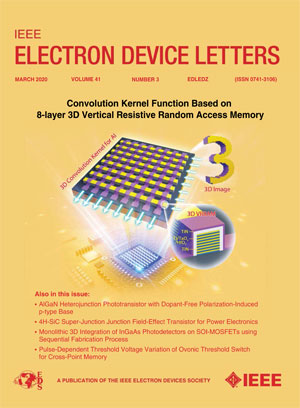Enhanced Capacitive Memory Window by Improving Remnant Polarization in Ferroelectric Capacitors for Non-Destructive Read
IF 4.1
2区 工程技术
Q2 ENGINEERING, ELECTRICAL & ELECTRONIC
引用次数: 0
Abstract
The unique concept of a non-volatile capacitive memory window (CMW) in ferroelectric (FE) capacitors (FeCAP) allows for a non-destructive read operation (NDRO). NDRO decouples the read- from the write-endurance which is ideal for random access memory and compute-in-memory applications. However, the optimal strategy to further improve the CMW remains uncertain. In this work, we first identify potential pathways to improve the CMW by studying the dependence of the relative dielectric permittivity (改进铁电电容器残余极化增强非破坏性读取电容记忆窗口
铁电(FE)电容器(FeCAP)中非易失性电容记忆窗口(CMW)的独特概念允许非破坏性读取操作(NDRO)。NDRO解耦了读和写的持久性,这对于随机访问存储器和内存中计算应用程序是理想的。然而,进一步改善CMW的最佳策略仍然不确定。在这项工作中,我们首先通过研究FE的相对介电常数($\epsilon _{\text {r}}$)对残余极化(${P}_{\text {r}}$)和矫顽力场(${E} _{\text {C}}$)的依赖关系,确定了改善CMW的潜在途径。结果表明,对于给定的读偏置,具有较高的${P}_{\text {R}}$和/或较低的${E}_{\text {C}}$的FE堆栈可以提高$\epsilon _{\text {R}}$和CMW。接下来,我们通过实验证明了这一点,并表明具有增强的$2{P}_{\text {R}}$的三层FeCAP获得了~20的高CMW $_{\epsilon}$,比之前的最佳值提高了~1.5倍。最后,我们展示了一个基于脉冲的NDRO,证实即使在$10^{{11}}$ NDRO周期后,CMW也有1.5倍的鲁棒增强。
本文章由计算机程序翻译,如有差异,请以英文原文为准。
求助全文
约1分钟内获得全文
求助全文
来源期刊

IEEE Electron Device Letters
工程技术-工程:电子与电气
CiteScore
8.20
自引率
10.20%
发文量
551
审稿时长
1.4 months
期刊介绍:
IEEE Electron Device Letters publishes original and significant contributions relating to the theory, modeling, design, performance and reliability of electron and ion integrated circuit devices and interconnects, involving insulators, metals, organic materials, micro-plasmas, semiconductors, quantum-effect structures, vacuum devices, and emerging materials with applications in bioelectronics, biomedical electronics, computation, communications, displays, microelectromechanics, imaging, micro-actuators, nanoelectronics, optoelectronics, photovoltaics, power ICs and micro-sensors.
 求助内容:
求助内容: 应助结果提醒方式:
应助结果提醒方式:


